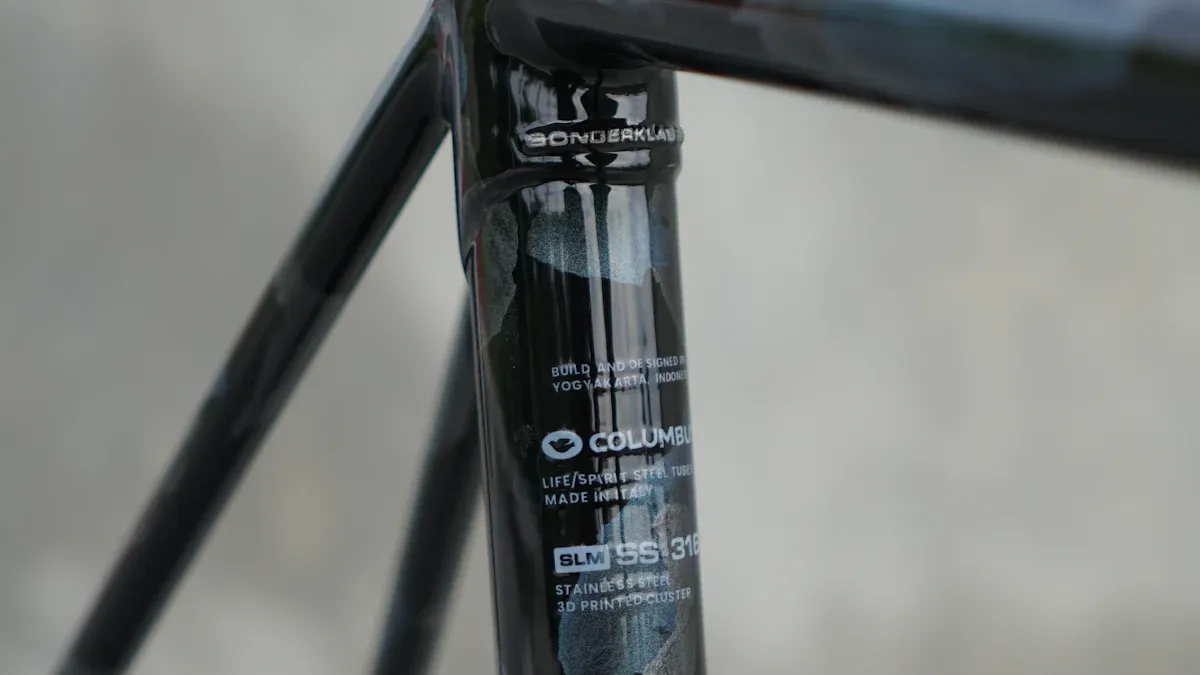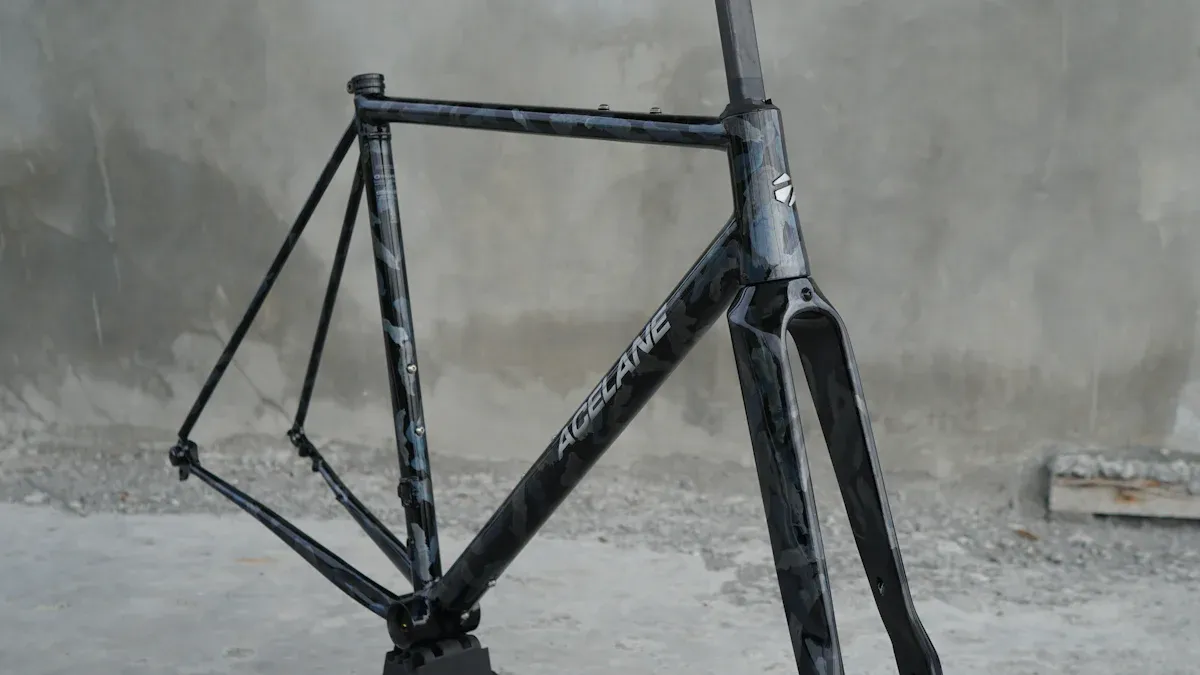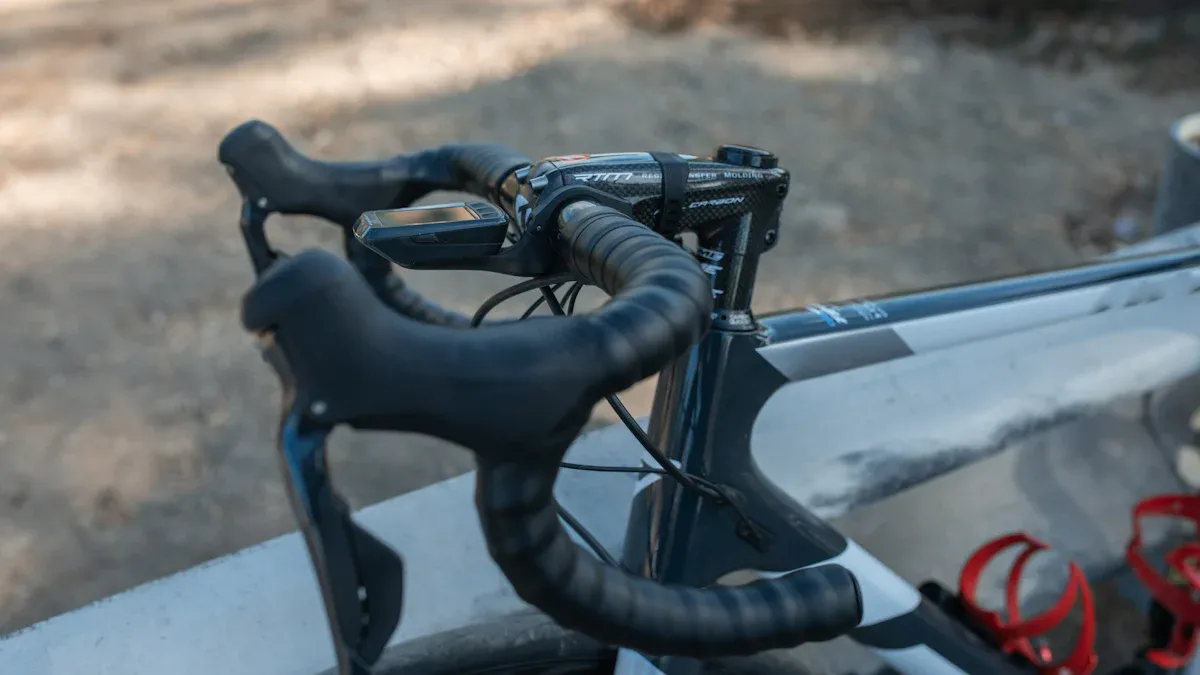
Carbon bike frame builds offer numerous advantages for cycling enthusiasts. They are incredibly lightweight, making them ideal for high-speed bikes. Additionally, they provide enhanced stiffness, which contributes to improved power during rides. Recent studies indicate that advancements in manufacturing allow for greater customization of these frames.
The market for carbon bike frame builds is expanding rapidly. It is projected to increase from USD 2.5 billion in 2023 to USD 4.8 billion by 2032. This growth is driven by the demand for lighter bicycles. This trend underscores the importance of understanding how to build carbon bike frames effectively.
Key Takeaways
Carbon bike frames are light and strong. This makes them great for speed and performance. – Picking the right carbon fiber type and resin system is very important. It helps with durability and ride quality. – Making your bike frame special through custom engineering improves comfort and performance. – Knowing the building methods helps create a strong and effective carbon bike frame. – Taking care of your carbon bike frame can make it last longer. It keeps it in great shape.
Materials for Carbon Bike Frame Build

When you build a carbon bike frame, the materials you choose are very important. They affect how well the frame performs, how heavy it is, and how long it lasts. Knowing about the different types of carbon fiber and resin systems will help you make good choices for your custom build.
Carbon Fiber Types
Carbon fiber comes in many types. Each type has special features that change how carbon fiber bicycle frames perform. Here are the most common types:
Plain Weave: This is the most popular type of carbon fiber. It has equal strength in all directions. This makes it light and very stiff.
Twill Weave: This type has a diagonal pattern. It looks nice and has a great strength-to-weight ratio. You usually see it in high-end frames.
UD (Unidirectional) Weave: This type is strong in one direction. It is perfect for important parts of the frame. It gives amazing performance.
3K, 6K, and 12K Weaves: These types vary in thickness and strength based on fiber bundles. The 3K weave is a good mix of cost and performance.
Hybrid Weaves: These combine different weaves. They improve both looks and strength, allowing for better performance.
The mechanical properties of these carbon fiber types greatly affect bike frame performance. For example, high-modulus carbon fiber gives the best stiffness and power transfer. This makes it great for racing. On the other hand, standard-modulus carbon fiber gives a smoother ride. It improves comfort without losing performance.
Resin Systems
The resin system you pick also changes how long your carbon bike frame lasts and how heavy it is. Here are some top resin systems used in making frames:
Resin System | Advantages |
|---|---|
Epoxy Resin | Great strength-to-weight ratios (~60:40) |
Newport 301 | Different fiber modulus and drapability |
Prepreg | Holds fiber together, made for manufacturing |
Epoxy resin systems are popular because they have great strength-to-weight ratios. They improve the frame’s overall performance. The Newport 301 resin system allows for different fiber modulus and drapability. This helps make the frame fit specific performance needs. Prepreg materials ensure good engineering during the making process.
The quality of the resin with carbon fiber really affects how long the frame lasts and how heavy it is. Good carbon strands and careful layering make a strong and durable frame. Bad materials can make it wear out faster. With good care, carbon frames can last over ten years. They also do not rust like metal, which helps them last longer.
Besides carbon fiber and resin, other materials can boost your bike frame’s performance. For example, composite inserts make the structure stronger and help bond with carbon fiber during making. Foam cores help reduce vibrations and keep support without collapsing when molded.
By learning about these materials, you can make smart choices. This will improve your carbon bike frame build and make sure it fits your performance and style needs.
Building Techniques for Carbon Fiber Bicycle Frames

Building a carbon bike frame needs some important techniques. These techniques make sure the frame is strong, light, and works well. Knowing these methods helps you see the skill in each custom build.
Weaving and Cutting
The first step is picking the right weaving pattern for the carbon fiber. Different weaves have special performance characteristics. Here are some good weaving patterns:
Unidirectional (UD): Gives the most strength in one direction. This is great for bike frames.
3K Weave: Balances strength and weight. It is often used in bike parts.
12K Weave: Stiffer than 3K. It works well where weight is not as important.
Weave Type | Flexibility | Strength Distribution | Appearance | Best Use Cases |
|---|---|---|---|---|
Plain Weave (1×1) | Low | Uniform | Checkerboard | Tooling, flat panels |
Twill Weave (2×2) | Medium | Balanced | Diagonal ribbing | Automotive, curved parts |
Satin (5HS, 8HS) | High | Directional | Smooth glossy | Aerospace fairings, aerodynamics |
Unidirectional (UD) | Very Low | One-directional | Minimal | Bike frames, spars, prosthetics |
After choosing the weave, cut the carbon fiber sheets carefully. Cutting accurately is very important. It makes sure the fiber weave and direction match when putting it together. If they do not align, it can create weak spots, making the frame less strong and effective.
Lay-Up Process
The lay-up process is very important for making a carbon bike frame. It starts with cutting big sheets of pre-preg carbon into smaller pieces. You arrange these pieces in a specific order inside a mold, following a layup schedule. This schedule is like a puzzle, making sure each piece fits just right.
Proper ply orientation is key. It helps the resin flow well and stick together, which reduces problems like air pockets and fiber wrinkles. After laying up the pieces, you vacuum seal the mold and remove air. Finally, you heat and pressurize the mold to make sure the resin flows well and the layers stick tightly. This process greatly improves the frame’s strength.
Molding Techniques
Molding techniques are very important for the final quality of your carbon bike frame. Here are some common methods:
Molding Technique | Description | Benefits | Drawbacks |
|---|---|---|---|
Uses an inflatable bladder to push on carbon and resin in a mold. | Low production costs after making the mold; allows for complex shapes. | Limited shape changes after making the mold; possible voids from pressure issues. | |
Foam Core Molding | Like bladder molding but uses heat-activated foam for pressure inside. | Gives support and reduces vibrations; makes repairs easier. | Same shape limits and pressure issues as bladder molding. |
Roll-Wrapping | Carbon fiber is rolled around a mandrel and cured. | Allows for custom ride quality and frame shape. | Takes more time; hard for mass production. |
Filament Winding | Carbon fiber is wound around a mandrel with heat-shrinking tape. | Similar benefits to roll-wrapping; reduces voids. | Also takes more time and is tough for mass production. |
Each molding technique affects the weight and strength of the frame. For example, bladder molding can cause flaws that weaken the frame. On the other hand, methods like roll-wrapping allow for customization while keeping strength.
Testing the frame after molding is very important. It makes sure the frame is safe and works well. You should do dynamic fatigue tests, stationary load tests, and impact tests to check durability and performance.
By learning these building techniques, you can make a carbon bike frame that looks great and performs really well on the road.
Custom Carbon Bike Options
When you think about building a custom carbon bike, many choices open up. Two important areas to focus on are special engineering and picking parts. These things greatly affect how your bike performs and fits.
Bespoke Engineering
Bespoke engineering lets you make a bike just for you. Here are some good things about this method:
You work with engineers to decide on the shape and ride feel. This makes sure the bike fits your body well.
The design includes detailed drawings and 3D images. This helps you see what your bike will look like before it’s built.
Customizing based on your size improves speed and comfort. You can choose which one is more important for your riding style.
Using advanced materials and building methods makes your ride better. With bespoke engineering, you get improved performance, making your bike truly yours.
Component Selection
Choosing the right parts is very important in making a custom bike. The frameset is the main part of your bike. Picking the right one gives you more options in size and shape. This flexibility is key to meeting your needs.
When picking a fork, look closely at the rake. This feature greatly affects how your bike handles and steers. Making sure all parts work together is also very important. Parts that don’t match can cause problems and hurt your riding experience.
New trends in customizing looks focus on unique paint options. In 2023, a new production line started to meet the need for custom designs. You can create special paint jobs with effects like ice crack, hand-drawn, and gradient. This trend shows a move towards personal styles in cycling, letting you show who you are.
By focusing on bespoke engineering and careful part selection, you can build a custom carbon bike that fits your performance needs and shows your personal style.
Production Workflow for Carbon Bike Frame Build
Building a custom carbon bike frame has a detailed process. Each step makes sure the final product fits your needs and works well. Here’s how the workflow usually goes:
Initial Consultations
The first meeting is very important for understanding what you want. During this time, you will talk about your likes and needs with the builder. Here are some key points discussed:
Bike Fitting: A good fit is key for comfort and performance.
Rider Preferences: You will share your riding style, goals, and any special design choices.
Measurements: Be ready to give details like saddle height, handlebar reach, and stem length.
Background Discussion: Your cycling history and any injury issues will help shape the design.
Physical Assessment: This helps find the best bike position for your body.
Component Recommendations: You will get advice on good parts like groupsets and handlebars.
This careful consultation lays the groundwork for the whole production process.
Frame Assembly
After the design is set, the frame assembly starts. This process has several steps to make sure the frame is strong and works well:
Making the Core: Begin by making the frame core with polystyrene foam rods. Wrap them with fiberglass for extra strength.
Laminating: Put the first layer of carbon cloth over the foam core. Use electrical tape to ensure it sticks well.
Laminating 2: Add more layers of carbon cloth, sanding between each layer for a smooth finish.
Laminating 3: Use diagonal and cross-wise layering for strength, especially in tough spots.
Finishing: Cut off extra carbon, sand the surface, attach cable stops, and add a clear varnish for a nice look.
Quality control is very important during assembly. Here are some checks done to ensure the frame is strong:
Check for air leaks by putting the frame in water and using an air gun. If no bubbles show up, the frame is good.
Make sure the frame is flat on a platform, checking that the left and right sides of the rear seat stay and chain stay are even.
Inspect the right side of the frame with height gauges to ensure it lines up with the bottom bracket (BB).
Measure the down tube and top tube for alignment, making sure they are within 1.5mm tolerance.
Final Delivery and Testing
The final delivery and testing of your custom carbon bike frame includes strict safety and performance checks. Here’s what to expect:
Safety Tests: These follow industry rules, including static, fatigue, and impact tests to check the frame’s strength under different conditions.
Performance Assessments: The frame is evaluated for weight, comfort, handling, stiffness, and aerodynamics.
The manufacturing process includes cutting pre-preg carbon fiber, making unique molds for each bike design, and ensuring production matches desired performance features.
Here are some specific tests done:
ISO 4210-6:2015 Fatigue Test: Simulates long-term use through repeated loading.
EN 14781 Impact Test: Checks how well it absorbs impacts.
ISO 4210-2:2015 Static Strength Test: Measures how well the frame holds up under static loads.
ISO 4210-3:2015 Frame Stiffness Test: Looks at lateral and twisting stiffness.
EN 15194 Corrosion Resistance Test: Tests how well it resists rust.
After passing these tests, the frame is ready to be delivered. The manufacturer keeps in touch with you throughout the process. You will get updates and can ask questions at any time.
Taking care of your carbon bike frame is important for its life and performance. Regular cleaning helps remove dirt and debris that can cause wear. Checking for cracks or damage can stop bigger problems. Tightening parts correctly ensures safety and performance. If you see any big issues, getting professional help is smart. This careful approach keeps your bike in great shape.
Building a custom carbon bike frame has many important steps. These steps go from picking materials to testing the final product. Here are some good reasons to choose a custom build:
Personalization: Change parts for a perfect fit and performance.
Cost-Effectiveness: Save money by using parts from your old bike.
Enhanced Satisfaction: Enjoy a bike made just for you.
Feature | Benefit |
|---|---|
Superior Weight-to-Strength Ratio | The strongest and lightest material available |
Vibration Dampening | Better ride quality |
Customizable Stiffness | Change flexibility in different areas |
Think about the options for making your own bike frame. Your custom build can make your cycling experience even better!
FAQ
What are the main benefits of a carbon bike frame?
Carbon bike frames are very light, strong, and long-lasting. They help transfer power better and give a smoother ride. These qualities make them great for racing and long rides.
How long does a carbon bike frame last?
If you take care of it, a carbon bike frame can last more than ten years. Regular check-ups and maintenance can help avoid damage and make it last longer.
Can I customize my carbon bike frame?
Yes, you can make your carbon bike frame unique. You can pick the shape, parts, and even paint designs to fit your style and needs.
What maintenance does a carbon bike frame require?
You should clean your carbon bike frame often to get rid of dirt and dust. Check for cracks or damage, and make sure all parts are tight for safety and good performance.
Are carbon bike frames more expensive than aluminum frames?
Yes, carbon bike frames usually cost more than aluminum ones. The special materials and making methods raise the price, but the performance benefits often make it worth it.
See Also
Top Reasons Cyclists Prefer Carbon Bike Frames in 2025
Exploring the Innovations of Carbon Fiber Bike Frames
Comparing Carbon Race Bike Frames for Your Best Ride
